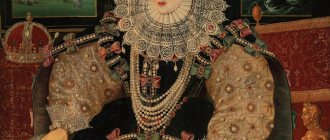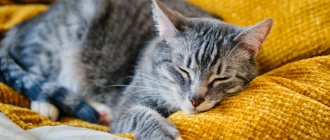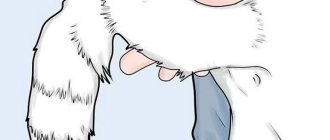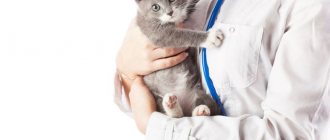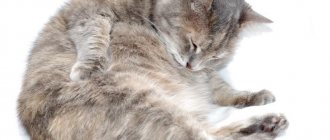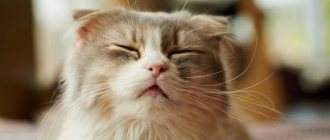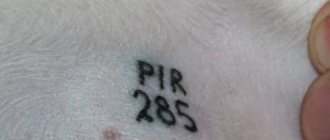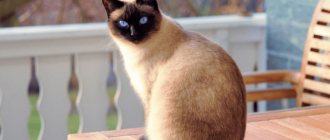Features of the tail structure
The cat's tail is an extension of the spine, so it consists of vertebrae. Depending on the breed, their number reaches 27, while the length of the tail is 40-50 cm. Like the whole body, it is covered with muscle tissue and skin.
Features of the structure of a cat's tail
In tailed breeds it consists of three parts:
- Root. 4-6 fused vertebrae that start from the sacrum.
- Stem. A flexible part of 10-15 elongated vertebrae. Between them are cartilages that connect the joints, which are surrounded by jelly-like intervertebral fluid.
- The tip of the tail. The vertebrae shorten closer to the end and become thinner. The last vertebra does not have connecting cartilage, so it grows in any shape.
Why is it needed?
A cat's tail performs many vital functions:
- keeps balance;
- helps to navigate in space;
- controls the process of thermoregulation;
- as a way of communication;
- one of the health indicators;
- just for beauty and entertainment.
And now in more detail about each point why this organ is needed.
Tail and cat mood
How to determine a cat's mood?
In its natural state, when it is down or wrapped around the paws, a cat's tail signifies calmness. However, they can express a dozen more different emotions! The most common ones are described in the table below.
| Position | Mood |
| Disheveled and drooping | Scared |
| Raised high | Glad to meet you |
| Lowered, mobile | Bad mood |
| Raised with curved tip | Happy, wants to be friends |
| Raised high, agile | Excited, glad to see |
| Pressed down, root raised | Feeling scared or guilty |
| Raised and disheveled | Feeling threatened |
| Curls along the body | In love |
| Sticks out back, tip is turned inward | Shows affection |
A joyful kitten runs towards its owner
What do tail movements mean?
In addition to the position of the tail relative to the body, the cat makes various movements, which can also be used to determine its emotional state:
- a lowered, motionless tail indicates that the pet is disappointed or very tired;
- raised up, when only the tip moves, means joy;
- smooth movements at a medium level show his interest in the situation;
- small amplitude of movement - he is in thought;
- wide scope - sexual attraction;
- a large amplitude combined with the beating of the tail on the floor indicates the cat’s irritation, dissatisfaction, and anger;
- hits the sides, which means he is preparing for a fight.
The tip of the tail rises when the cat is nervous
Tailless animals are limited in emotional communication. They cannot correctly convey their feelings, mood, desire. This is comparable to having fingers for a person who does not speak sign language.
Balancing
Cats need a tail even when hunting.
The cat unconsciously uses this function, since the opportunity is gifted by nature itself. With the help of the tail, you can freely control your body, perform maneuvers during the hunt, and overcome obstacles unimaginable to humans. When a cat falls or jumps from a height, it maintains body balance and helps to take a safe position for landing. This occurs due to free rotation and twitching. It also allows you to maintain balance on turns and narrow surfaces, and acts as a rudder when swimming.
Maintaining balance is the main function of a cat's tail.
And the fan and the blanket
Many people know about this from folk superstitions: a cat curls up into a ball and covers its nose with its tail when cold weather is approaching, and fans itself like a fan when the air temperature is high. Such actions help the animal control its body temperature, raising or lowering it, while the tail is a tool for thermoregulation.
One of the functions of a cat's tail is thermoregulation.
Intimidating enemies
When a cat is seriously frightened, the fur all over the body stands on end, and the tail is fluffed to the maximum, raised high and arched. This pose makes the animal appear larger and scarier than it actually is, which is why many representatives of the animal kingdom resort to such an effective trick to intimidate their enemies.
Even among closely related species, there are rituals that make it possible to determine who is in charge without a fight. So cats will prefer to howl for a long time and terribly, spinning around each other before starting a fight. And a large fluffy tail will help its owner gain the necessary superiority in this matter.
Entertainment
In addition to the important functions described above, the tail can be useful for games. If your pet has few toys nearby or wants to exercise and have fun, he can easily focus on his own tail. Its constant active movements perfectly imitate a potential prey that can be hunted.
What does the tail look like when the kitten is in a playful state?
It is important to understand that the cat knows that the tail is part of its body, and not an enemy or prey. She will never harm herself, so there is no need to worry about it, much less deliberately interfere with play. After playing, as a rule, the animal begins to intensively care for its tail in order to bring it into proper shape.
conclusions
Although cats without tails live no worse than their tailed counterparts, the latter predominate over the former. Nature generously endowed her mustachioed children with this useful tool, and does not think of taking it away. Happy owners of tails can count on him to help them:
- In maintaining balance. Although the tail is not the main thing for this, it is easier for a cat to steer and maintain balance when walking along a tree branch or fence.
- Warm up and cool down. On frosty days, animals curl up into a ball and cover their nose with the tip of their tail, and on hot days they stretch out to their full length.
- In expressing feelings. The tail is a pipe - the pet is happy, tucked - scared, very fluffed and twitching nervously - ready to attack, and this is only a small fraction of gestures.
Video
The influence of cat age and breed on tail length
The length is measured from the sacrum to the extreme point of the last vertebra. In long-tailed cats it ranges from 20–28 cm to 40 cm, which depends on the individual characteristics of the cat and its breed. For example, Persians have a shorter average length than Oriental cats, while Maine Coons have a longer tail than both.
How does a cat's age affect tail length?
The length also depends on the age of the animal, because kittens have the same number of vertebrae in their tail as adults. However, during growth, the width and length of the caudal vertebrae increase, so it becomes longer.
Basic physiological functions
Anyone who cannot understand why a cat needs a tail should remember that it performs important physiological functions for the animal. With its help, the cat communicates with the outside world, expresses its emotions and protects itself from enemies. It makes navigation easier, improves hunting performance and reduces the risk of injury to the cat.
Thermoregulation
What smells do cats not like: what are they afraid of and what scares them away?
The tail is an excellent regulator of the animal’s body temperature. In hot weather, the cat uses it as a fan. With its help, it creates a breeze and cools down. And when it’s cool, it warms itself by curling up in a ball and covering itself with its tail like a blanket.
Balancing agent
One of the main purposes of a cat's tail is for balancing. It, like a person’s hand, helps to maintain balance. Animals climb tall trees, balconies and often fall from heights. Thanks to their tail, they are able to maneuver in the air and land on 4 paws. This minimizes the risk of injury.
Interesting! Even having fallen from a great height, above the 6th floor, a cat can get away with just a slight fright.
Successfully balancing with the help of its tail, the animal can easily walk along thin branches and narrow cornices.
Can a cat live without a tail?
If a cat has lost its control organ during an injury, it will be difficult for him to cope with balance, emotions, and orientation in space for some time. However, they are able to adapt to a new life quite quickly: they maintain balance due to better developed joints, they become more flexible and bend better, and they convey their mood with their mustache, ears and behavior.
Can a cat live without a tail?
The second case when a cat may find itself without a tail is an innate property.
But does she really need him?
In fact, not very much, the cat can do without it, and without much damage. For example, cats that have lost their tail as a result of injury continue to jump, climb trees, and walk on roofs and fences no worse than their tailed counterparts. When falling from a height during the process of self-leveling, a cat, in addition to balancing with its tail, uses other possibilities, so it is ready to land on its paws without the participation of its tail. And to express emotions, you can give signals by moving your head and whiskers, using your eyes, ears, claws and paws. All owners of tailless cats understand their pets very well.
Tailless breeds
There are completely tailless breeds: Manx. Kymrik. The complete absence of a tail is a genetic damage for which the M gene is responsible. Because of this genetic feature, the breed is not allowed to be bred with other species in order to avoid unhealthy offspring.
The Manx taillessness gene is dominant, that is, if at least one of these is present, it a priori causes the absence of a tail. If the kittens are homozygous (with two copies of the tailless gene), the pregnancy spontaneously aborts, so they are bred from different parents: one tailed and one tailless. However, kittens with one gene also have an increased risk of Manx syndrome, which is characterized by spina bifida, fused vertebrae, and bowel and bladder problems.
There are cat breeds that have a tail, but it is shortened. Bobtails (Kurilian, Japanese, Karelian, American, Mekong) have only 5-7 vertebrae. They are heavily pubescent and resemble a pompom in appearance. The gene that causes the broken tail is recessive—you need to have two copies of it for it to work. In addition, the Bobtail gene does not cause health problems like the Manx gene.
How tailless cat breeds are born
Beauty and charm
For most owners, these are the qualities that are decisive when choosing a pet cat. Animals are used less and less to fight rodents and are increasingly perceived as living toys. But even if a kitten was born and raised in ideal conditions, has not seen the street in the third generation and has never needed anything, the instincts of a wild animal will still awaken in it, at least occasionally.
It is for this reason that pet fluffies sometimes upset their owners with little pranks, tearing soft toys to pieces, scratching wallpaper or jumping on curtains. This happens even to the most thoroughbred individuals. After all, no matter how cute, affectionate and good-natured a kitten may be, it is first and foremost a predator. And only then - everyone’s favorite, a living toy or decoration of the sofa in the living room.
The tail is an indicator of health
This organ is not only a natural extension of the spine, but also has many nerve endings, which is important in determining the health of the cat:
- When the tail is dislocated, it maintains an unnatural position or bend. In this case, the help of a veterinarian, x-rays and further dressings for recovery are necessary.
- It looks like beads, which means the animal lacks calcium. The vertebrae become thinner, and the cartilage tissue grows.
- Clicking noises when moving are often caused by problems with interosseous and cartilage tissue.
- The cat walks with his tail raised, the tip of which twitches, while he slightly spreads his paws. Most likely the behavior is caused by urolithiasis.
What to do if your cat's tail is going bald
If there is severe hair loss from the tail, stress, dermatitis, or allergies can be assumed. In order to avoid complications (bacterial, fungal infection), you need to consult a doctor to monitor the condition. Common health indicators that can be determined by tail hair include:
- prolapse at the base (on the sacrum) is a sign of a lack of vitamins;
- the appearance of dandruff - an allergic reaction or fungus;
- Oily hair is a symptom of improper metabolism, hormonal disorders or diseases of the excretory system.
And the fan and the blanket
Besides balancing and communication, there are other (less remarkable) uses for a cat's own tail. In the summer heat, for example, you can see how the animal, stretched out in the shade, gently swings it over its own body. Thus, the cat tries to cool itself by moving air currents and creating a semblance of wind (based on the principle of a fan).
If the room is cold, the animal curls up into a ball, trying to minimize heat transfer. In this case, the tail often wraps around the body and covers the muzzle. It turns out that the animal uses the warmth of its own fur like a blanket, covering frozen areas (nose, paws).
It turns out that there is no clear answer to the question “why does a cat need a tail?” This is not just a beautiful, but also an extremely important organ, serving as a means of communication and a balancer, a fan and a blanket, and sometimes even a toy for the young. Knowing exactly how the animal uses it, and understanding what it wants to say with this or that movement, the owner can significantly improve their relationship with the pet.
Tailed diseases
To promptly notice if your pet is sick, you need to know the basic parameters of the cat’s body:
- body temperature from 37.5 to 39 °C (the younger the cat, the hotter it is).
- respiratory rate: the norm for adults is 17-23 breaths per minute, for young animals - 22-24, for kittens - up to 60.
- The pulse of a healthy cat is up to 130 beats per minute.
- The norm is also a vertical position of the tail, then we can say with confidence that the cat feels good and is happy with everything.
The most common diseases that affect the condition of the tail are fractures, parasites, fungal diseases and allergies.
Fractures
What does a broken tail look like in a cat?
There are several types of deformation of the caudal vertebrae:
- hall - the elevation of one vertebra above another like a step upward (they can be the same in length, but the edges are necessarily rounded);
- kink - step down;
- bending - the elevation of one or more vertebrae above an imaginary straight line;
- nodulation - several vertebrae have fused into one.
If the deformation is not noticed in time and the cat is not helped, the vertebrae may not heal properly. This may not greatly affect the pet’s health, but it will cause some discomfort in the cat’s daily activities.
Parasites
More often than fractures, problems occur with the skin and hair. Scratching, gnawing and other nervous behavioral reactions are symptoms of parasites. You can get caught by fleas, ticks, and lice eaters on the street while walking or from other animals. When your pet begins to violently attack its tail, you should carefully examine it for small black dots that parasites leave behind. Ticks are easier to identify; they are visible to the naked eye. To do this, you just need to move the fur near the bitten area.
To prevent parasites, experienced owners buy a treated collar or drops. It is also necessary to observe hygiene standards: combing, bathing, and caring for your pet’s fur. If the parasites do get there, be sure to contact your veterinarian, because in addition to anti-flea medications, you may need antiseptics.
Be attentive to your pet and be sure to treat wounds for parasites. If this is not done, constant gnawing of the skin will lead to the appearance of ulcers along the entire length of the tail, which can cause further damage to the animal’s skeletal system.
Fungal diseases
Itching is also caused by fungal diseases, some of which are contagious to humans, like lichen. You can recognize it by bald spots and light spots on the skin. They treat an infectious animal with antifungal agents, and additionally limit head movements with an Elizabethan collar (a cone on the head) so that the pet does not tear the affected areas. When contacting a veterinarian, you can get additional advice on health-supporting medications with a vitamin complex, and to get rid of the disease as quickly as possible, they recommend giving an injection.
Allergy
What diseases can be identified by a cat's tail?
Common sources of allergies: toilet litter, plastic toys, inexpensive food. At the same time, the cat scratches the entire body up to the tail, which is why redness and peeling appear in some areas of the skin. Only a veterinarian can recognize an allergy and prescribe the correct treatment (steroids and ointments for wound healing).
Care instructions
Caring for the tail, like the entire fur of an animal, is a necessary undertaking. After all, by its condition, the owner can understand the physical and emotional health of the animal. A few simple rules will help show you care about your pet:
- If your pet falls unsuccessfully, the tail remains in an unnatural position, and when touched it causes discomfort to the animal - you need to urgently contact a veterinarian and get an x-ray.
- If you see that a child or another person is pulling the cat’s tail, stop him. One sudden movement and injury to this organ will lead to failure of the hind legs and a negative impact on the functioning of the kidneys or intestines.
- Also monitor the condition of the fur on it. Dandruff, bald spots, white spots, violent gnawing are painful symptoms. For consultation, we recommend contacting a veterinarian; perhaps the kitten lacks vitamins, or there may be parasites on its body.
- If the cat walks drooping, the tail hangs down without moving at all - this is also a sign of an unhealthy condition.
Tail up means the cat is happy!
To keep the fur shiny and the pet’s health at an excellent level, experienced owners recommend bathing it once every three months, combing it 2-3 times a month to remove all dead hair, feeding it with professional food and keeping the tray clean. This is enough for the cat to be healthy and make its owner happy with its condition!

